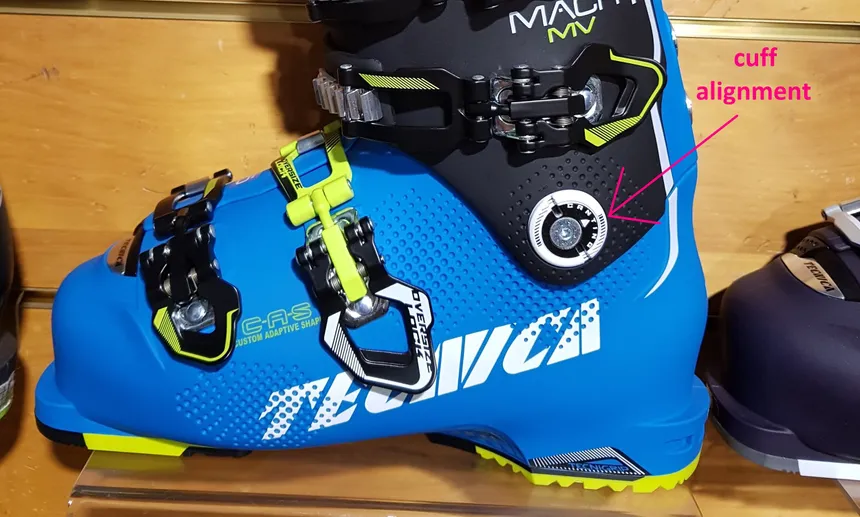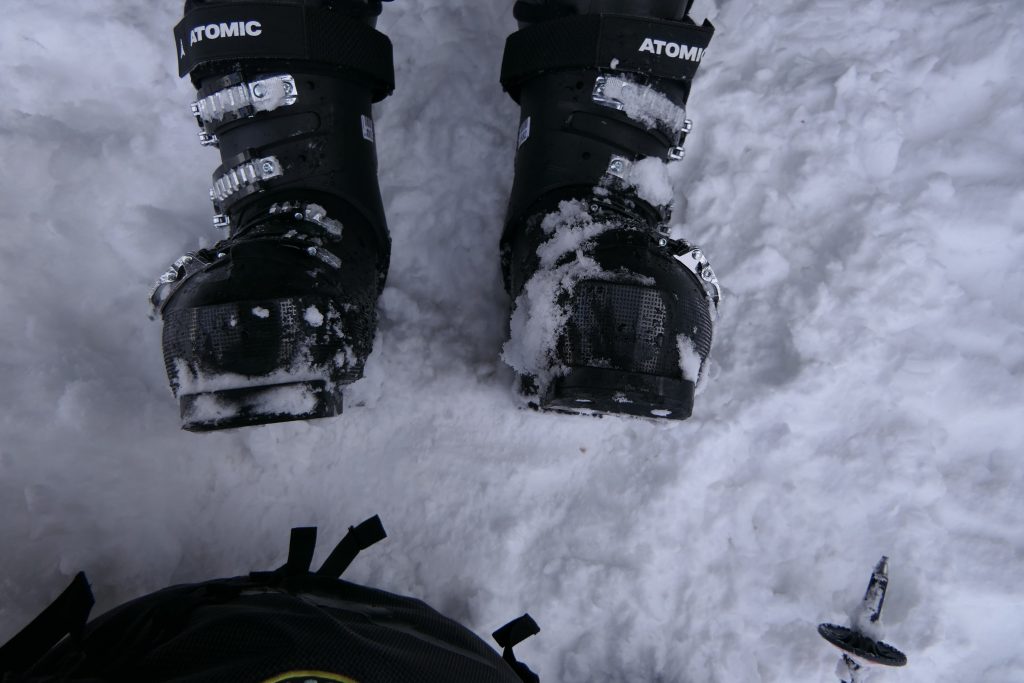Feedback
Normally I’d have taken video to post here but we only got into technical stuff progressively through the morning – which was more centred on everyone finding their ski legs and getting familiar with the ski station.
Ella skis nicely using a lot of natural dynamics (inclination) and then copes well with ice due to good hip angulation when completing turns. Ella’s limits however showed up when asked to make dynamic skating step turns with independent use of the legs and remaining centred fore/aft. If we had flatter terrain available we would have practised this more carefully!
Teddy tends to push the tails out at the start of the turns – instead of pushing the mass of the body into the turn. This is probably due to “facing the upper body downhill”. However this allows Teddy to have some hip angulation when completing his turns and gives some security on the ice. We are going to look into how to create proper hip angulation tomorrow.
Alex: Building dynamic range and practising skating turns will help make a more effective skier. There was very little hip angulation (or control) on the ice – so this needs to be addressed tomorrow. Tension the anterior tibialis to stay off the backs of the boots.
James is a bit tense but is developing awareness of dynamics/skating with adductor muscle use and the feet everted. The ice is challenging but will become easier after working on hip angulation tomorrow.
The first module (Dynamics 1) is not there to put you off- it’s there for reference to the right Newtonian laws (just in case anybody asks!).
Dynamics 2 (Skis Parallel)
- Skis must be travelling forward – like a bicycle
- This is mainly about using the outside leg (start of new turn) to push the centre of mass into the centre of the new turn – for the whole duration of the turn
- There is no “balance” when skiing – dynamics is the physics of disequilibrium
- You are looking for stability from organised accelerations (ski technology!)
- Notice in the photos below the outside leg is essentially straight in a skating action (flexion for absorption and other purposes is primarily at the hip joint)
- The centre of mass goes down toward the snow – and to complete the turn it comes back up – like a motorbike in a turn
- There is no “Centrifugal Force” acting on the skier – only a deflection inward away from a straight line. This deflection is used to lift the skier up at the end of the turn – which involves “finishing” the turn – I.E. turning almost back up the hill.
- Remain square to the skis (follow the skis around the turn with your body) until you are really comfortable with movement of the centre of mass and clearly aware of moving it.
Model photos showing unambiguous dynamics…



Skating/Adductors
Skiing is just disguised skating. The main difference is the skis are wide and have two edges. When diverging the skis outwards at the tips into a skating stance the skis want to flatten on the snow and the stiff shaft of the ski boots will pull the knees outward. The adductor muscles need to be engaged to hold the skis on their inside edges. This is a pattern of muscle use – the adductors of both legs contracting – that should be maintained when skiing parallel. This is partly dependent on the skier’s morphology. If the femurs are naturally directed inwards less adductor use might be appropriate but if slightly bow legged there may be a need to consciously work the adductors.
Only when snowplough braking should the adductors be released to widen the spreading of the tails of the skis from the hip joints.

The other difference between skis and skates: – it’s just that skis bend and scribe arcs on the ground and are generally used on slopes not flat lakes. Skating actions are fundamental for a skier’s development because they involve independent leg action where only one leg at a time is really used. Although skiers can stand on two feet the body is oriented specifically on one hip joint at a time (when turning) and has to function as if standing on one leg. Skating exercises such as skating step turns are helpful in developing basic skills. Skating turns use diverging skis (opposite from snowplough) and incremental stepping of the centre of mass inward toward the turn centre. This is ideally the first sort of turning that any complete beginner should experience – on flat terrain
Everting the Feet
When the skis are parallel the feet still “diverge” (as if skating) inside the ski boot – each foot being turned outward (everted). This obviously isn’t visible. This is to combat the tendency to twist the foot inwards to”turn” the ski directly -a mistake which flattens the ski and causes loss of grip.

Ankle Flex (Anterior Tibialis Contraction)
One way to increase pressure on the ski fronts is to flex the ankle inside the ski boot – not by squashing the ankle but by lifting the forefoot toward the shin and creating shin pressure on the cuffs of the ski boots. The boots then act as a lever transmitting force to the ski fronts. Gripping on ice requires pressure on the ski fronts and is strongly aided by the (upward) flexed ankle. Turning power comes mainly from the ski fronts – pressure on the tails of a ski makes it travel straight ahead.
Contracting the shin muscle protects the knee joints.
Keeping the ankle flexed (upwards) protects the knee and helps keep pressure on the front of the ski boot – even while extending the leg.
Extending the (flexed) uphill leg in a turn transition/initiation also serves to protect the knee joint from excessive strain through the quadriceps as the turn progresses.
Ski Boot Alignment
Good quality ski boots have the ability to adjust the angle of the shafts laterally so that they can conform accurately with the skier’s morphology.


Shops always have you standing in the boots and bending the ankles, knees and hips to assess whether or not alignment is correct. Sometimes they even prepare supportive footbeds to be added and have special contraptions that you can stand on – but the approach is completely wrong (most of the time).
Around 1995 I figured out the right way to align – it’s done sitting on the edge of a bench/chair with the legs completely straight out in front (knee joints must be totally straight) – no weight on them – feet hip width apart (parallel) – toes vertically aligned (not with the toes rolled inward or outward) and hip joint flexed with the lower back straight and upright. The soles of the boots when correctly aligned are flat.
The top image below shows boots that need the cuffs canted toward the outside so the soles can be flat. If there is no canting mechanism or appropriate tool available then cutting cardboard or plastic shims to insert on the inner side of the shaft between the shell and the inner boot will have the same canting effect (this was done with the boots below as a temporary measure). The skier previously had trouble gripping with the inner edges when skating and had developed a very wide stance to compensate for the lack of edge grip and response. Sometimes people (often women) can have the opposite problem with the ski boot too much on edge – so canting the shaft inwards is necessary instead.



